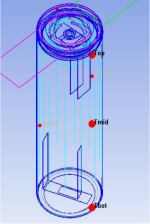BatteryMooch
10 kW
TL;DR…no. This cell uses the same tab design as other round li-ion cells, but has more tabs to reduce internal resistance and increase current handling.
Images:
Some observations and comments:
Images:
Some observations and comments:
- NEVER TAKE APART A LI-ION CELL! Even a tiny spark can ignite the flammable electrolyte that is everywhere in the cell.
- I used huge amounts of ventilation and I have a very specific method to make the cell fairly safe to handle.
- The top contact (cathode) uses two aluminum tabs, coming out at about 1/4 and 1/2 of the way into the jelly roll. Most other cells use just one tab.
- The cathode tabs are connected to jelly roll’s aluminum current collector foil using a huge number of tiny dots. Laser weld impact points?
- The bottom contact (anode) uses three tabs, coming out at the outside start of the jelly roll, about 1/3 of the way in, and a narrower tab from the end (center of the cell). Most other cells use one or two tabs.
- The anode tabs are the standard metal for this, copper, but appear to be nickel plated.
- The anode tabs are bonded to the copper current collector foil differently. All of the laser weld (???) impact points are bunched together at three locations.
- The only really obvious internal difference between the P50B and other high performance li-ion round cells is the larger number of tabs. This reduces the internal resistance and voltage sag of the cell.
- The rest of the P50B’s amazing performance is probably due to the active materials (anode, cathode, electrolyte) and the separator.
- I tested the P50B for my Patreon supporters in February and will be posting the results publicly soon. Some test results (performance beyond 300 abusive cycles, P45B/P50B abusive cycle life comparisons, and extremely high current discharges) will remain patron-only though.



